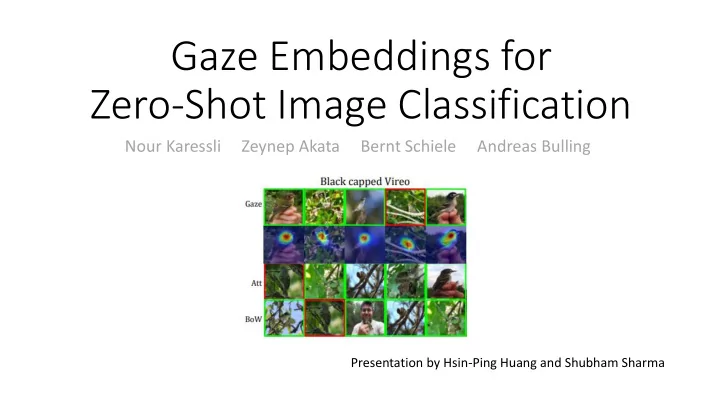

Gaze Embeddings for Zero-Shot Image Classification Nour Karessli Zeynep Akata Bernt Schiele Andreas Bulling Presentation by Hsin-Ping Huang and Shubham Sharma
Introduction Attributes • Standard image classification models fail with the lack of labels. • Zero-Shot Learning is a challenging Descriptions task. Side information, e.g. attributes, is required. • Several sources of side information exists: Attributes, detailed descriptions or gaze. • Use gaze as the side information in this paper. Gazes [Zero- shot learning tutorial, CVPR’17]
ZERO-SHOT LEARNING • Given training data and a disjoint test set, perform tasks such as object classification by mapping a function between the training data and test set.
GAZE EMBEDDINGS Gaze Features Gaze Histogram
GAZE EMBEDDINGS Gaze Features with Grid Gaze Features with Sequence
RESULTS OF THE PAPER
EXPERIMENTS
Dataset: CUB-VW • 14 classes of Caltech-UCSD Birds 200-2010 • 10 different splits: 8/3/3 for train, validation and test classes • Average per-class top-1 accuracy 7 classes of Vireos 7 classes of Woodpeckers
Gaze Features with Sequence GFS of One Observer GFS EARLY Observer 1 Observer 5 GFS AVG Observer 1 Observer 5
Experiment 1 • Gazes in the beginning contain less information because the observers just start viewing the image. • Gazes in the end contain less information because the observers are tired or have done the observation. • Ignore gazes in the beginning and the end. Gaze Features with Sequence (GFS) of One Observer
Experiment 1 Beginning End Accuracy (%) Accuracy (%) Beginning + End Sequence length Sequence length GFS AVG GFS EARLY • Ignoring gazes in the beginning yields better accuracy. • Especially for AVG, the accuracy improves 6% when ignoring 2 gaze points.
Experiment 2 • Gazes with shorter duration contain less information because those position are less salient in the image. • Ignore gazes with shorter duration. Gaze Features with Sequence (GFS) of One Observer
Experiment 2 Accuracy (%) Accuracy (%) Sequence length Sequence length GFS EARLY GFS AVG • Ignoring gazes with shorter duration yields better accuracy. • Especially for EARLY, the accuracy improves 6% when ignoring 5 gaze points.
Experiment 3 • Gazes close to the center contain less information because the observers have a tendency to look at the center. • Ignore gazes close to the center of the image.
Experiment 3 Accuracy (%) Accuracy (%) Sequence length Sequence length GFS AVG GFS EARLY • Ignoring gazes close to the center yields better accuracy. • Especially for EARLY, the accuracy improves 5% when ignoring 6 gaze points.
Experiment 4 • Not only the absolute positions, but also the offsets and distance between the mean gaze are informative. – Gazes have personal bias, each person have a different mean gaze. – The distribution of the gazes is important. • Add the offsets and distance between the mean gaze as features. D O y O x mean gaze
Experiment 4 • Add the offsets and distance between the mean gaze as features. Gaze Features with Sequence (GFS) of One Observer
Experiment 4 9% ↑ 8% ↑ 6% ↑ Accuracy (%) Accuracy (%) +O +D +OD +O +D +OD GFS EARLY GFS AVG • Adding the offsets and distance between the mean gaze yields better accuracy.
Experiment 5 • Not only the angles, but also the offsets and distance between two subsequent gazes are informative. – The saccade information is important. • Add the offsets and distance between the subsequent gaze as features. next gaze SD SO y SO x
Experiment 5 • Add the offsets and distance between the subsequent gaze as features. Gaze Features with Sequence (GFS) of One Observer
Experiment 5 2.8% ↑ 1.5% ↑ 1.5% ↑ Accuracy (%) Accuracy (%) +SO +SD +SOD +SO +SD +SOD GFS EARLY GFS AVG • Adding the offsets and distance between the subsequent gaze yields better accuracy.
Experiment 5 10.5% ↑ Accuracy (%) +O +D +OD +SO +SD +SOD +ALL GFS EARLY • Adding the offsets and distance between the mean gaze and the subsequent gaze yields the best accuracy.
Experiment 6 • Use different zero-shot learning models. Existing ZSL models can be grouped into 4: Learning Linear Compatibility 1.Learning Linear Compatibility: ALE, DEVISE, SJE Use bilinear compatibility function to associate 2.Learning Nonlinear Compatibility: LATEM, CMT visual and auxiliary information 3.Learning Intermediate Attribute Classifiers: DAP 4.Hybrid Models: SSE, CONSE, SYNC SJE: Structured Joint Embedding Gives full weight to the top of the ranked list [Akata et al. CVPR’15 & Reed et al. CVPR’16]
Experiment 6 Hybrid Models CONSE: Convex Combination of Semantic Embeddings Express images and semantic class embeddings Learns probability of a training image belonging to a class as a mixture of seen class proportions Uses combination of semantic embeddings to classify [Norouzi et al. ICLR’14] SSE: Semantic Similarity Embedding SYNC: Synthesized Classifiers Leverages similar class relationships Maps the embedding space to a model space Maps class and image into a common space Uses combination of phantom class classifiers to classify [Zhang et al. CVPR’16 ] [Changpinyo et al. CVPR’16]
Experiment 6 Gazes Attributes Method Accuracy (%) Method Accuracy (%) SJE 62.9 SJE 53.9 SSE 60.6 SSE 43.9 CONSE 63.7 CONSE 34.3 SYNC 62.2 SYNC 55.6 [Xian et al. CVPR’17] • Using different zero-shot learning models yields similar accuracy for gaze embeddings.
Experiment 7 • Check the contribution of every participant to check if they contain complimentary information. 1: (1,2,3,4,5) 2: (4,5) 3: (1,2,3,4) 4: (1,2,3,5) 5: (5) 6: (1,2,4,5) 7. (1,2,3) 8. (1) 9. (1,2) 10. (1,3)
Failure Cases • Birds are small or not salient in the pictures • Birds have very different poses
CONCLUSIONS • Using gaze embeddings for object recognition can be improved by processing the gaze data. • The zero-shot model used in the paper works better when we think about either gaze or attributes. • Not all participants necessarily contribute complimentary information.
Recommend
More recommend